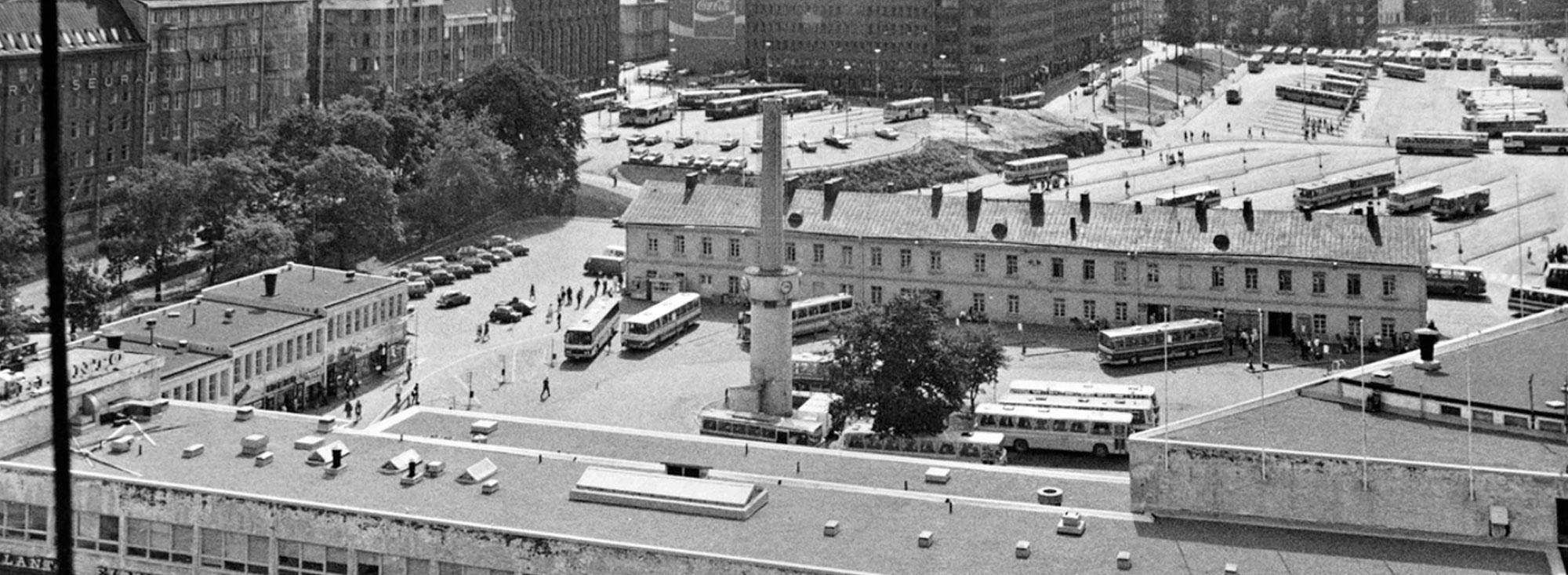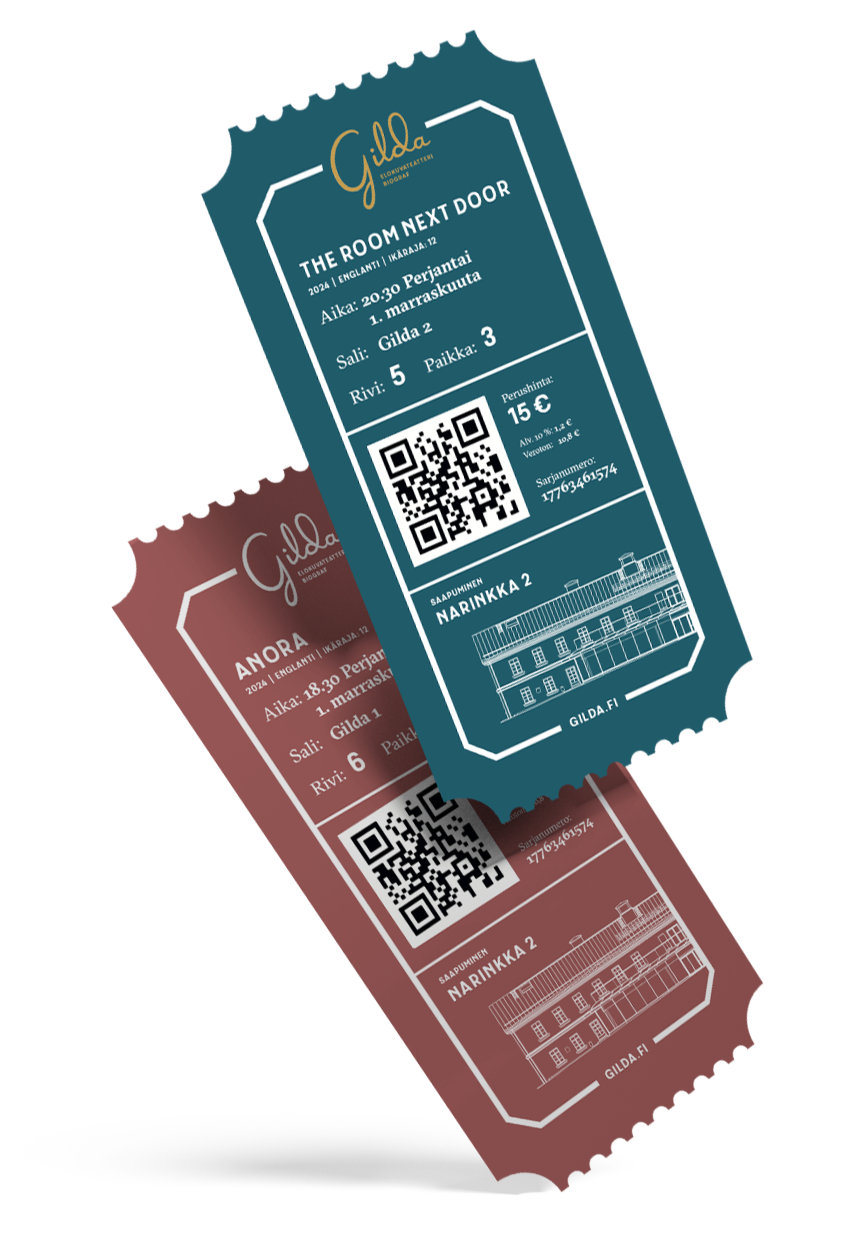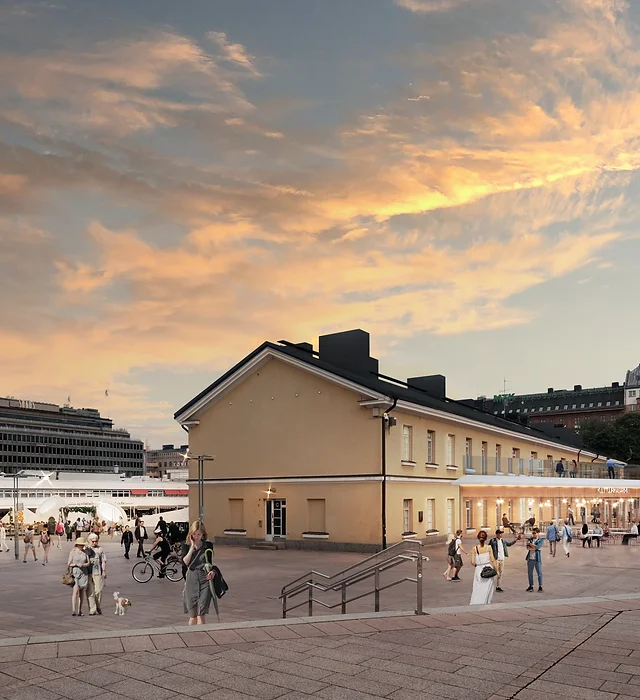
HISTORY OF GILDA
Gilda opens 1st November 2024
Independent boutique cinema Gilda opens to the public on November 1st, 2024. The cinema is operated by Oy Elokuvateatteri Gilda Biograf Ab. Before this, the BioRex Kulttuurikasarmi movie theatre operated in the premises from November 2023 to October 2024.
2023 Completion of Kulttuurikasarmi
In November 2023, a completely new entertainment centre opened in the heart of Helsinki, when Kulttuurikasarmi opened its doors in the old bus station building in Kamppi. Kulttuurikasarmi brought new life to the Lasipalatsi square and the entire Kamppi area.
Bio Rex Cinemas opened a brand new three-screen movie theatre in the building. NoHo Partners restaurants, bars, glass pavilion, and a large indoor event space with terraces also opened their doors. An event stage was built on the Lasipalatsi square, giving new opportunities for various types of performances and outdoor concerts.
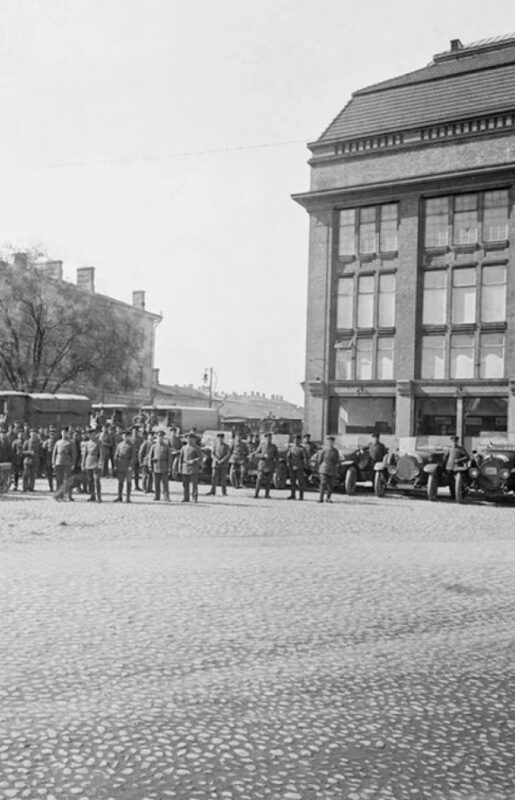
In the spring of 1918, the German soldiers participating in the liberation of Helsinki used Kamppi and the square known as Hankkijan aukio for various purposes. Food was distributed to the residents at Hankkijan aukio, as there was a shortage of sugar and bread. Photo: Eric Sundström, 1918.
Photo source: Helsinki City Museum archive / Helsinkikuvia.fi
Kamppi – the mysterious centre of Helsinki
Laura Kolbe, August 2023
Every major city has a main artery that leads people to an urban cityscape and to the beat of a modern life. In Helsinki, this passage is Mannerheimintie – and the Kamppi district next to it. The Mannerheiminaukio square is one of the key points in Helsinki. Today, all the main landmarks of politics, commerce, culture, and transport can be seen from there: Museum of Contemporary Art Kiasma, Musiikkitalo concert venue, National Museum, Parliament House, former main post office Postitalo, Lasipalatsi, Sokos department store, former Hankkija main office, Forum and Kamppi shopping centres, Helsinki central railway station, and Kamppi bus station.
Marching armies and an active marketplace
Historically, the Kamppi area has been large and poorly defined. For a long time, it remained outside of the city’s zoned area. In the 18th century, the sandy land where forests had been cut was used for military camps. During the 19th century imperial rule, it was a training area for the bourgeois guard. One of the capital’s large barracks areas, the Turku barracks, was built in Kamppi in 1833. In the spring of 1918, the Kamppi fields were used by German soldiers. In April 1918, the barracks were badly damaged by fire.
A less-known fact is that in the summer of 1943, during the Continuation War, the German military office Ortskommendantur rented an area of 1400 m² in Kamppi for a one-year lease. Barracks built by Finns were placed there, housing the German Feldgendarmerie office and a 120-person overnight barracks for passing German soldiers and non-commissioned officers. A small command post of the German secret police with detention booths was also located in Kamppi.
The ownership of the land where the Turku barracks stood had been transferred from the state to the city in 1934. The undeveloped land was handed over to serve as the site of a local and long-distance bus station, which started operating in a barracks-like auxiliary building that had survived the destruction of 1918. Traditional commerce continued in the region after the Civil War. The people of Helsinki knew the area as the Narinkka square. It was located in the place where Hotel Scandic now stands. Jewish and Russian merchants sold clothes and textiles there between 1876 and 1929. The Narikka square had been moved to Kamppi from the site of the current Bank of Finland head office, when planning of the bank building began in the 1870s.
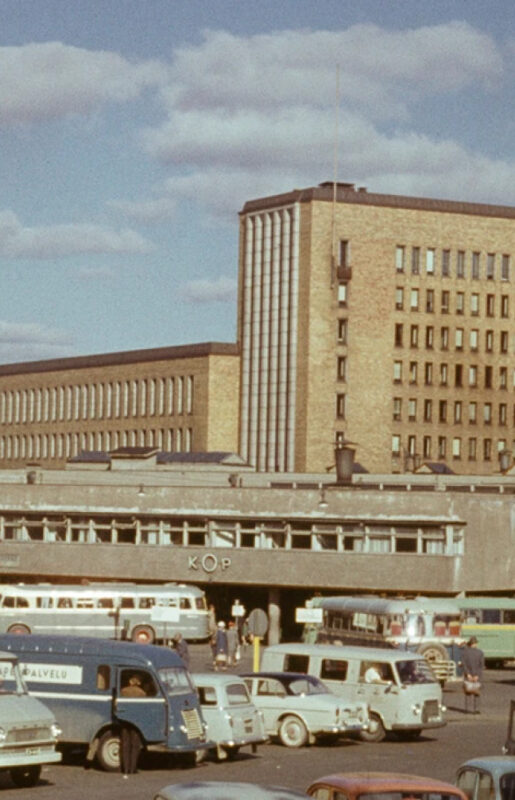
A new bus station, serving both local public transport and long distance buses, opened in 1936 in a former auxiliary building of the Turku barracks. After the wars, it developed into the centre of traffic in Helsinki – and the busiest place in the city. Photo: Constantin Grünberg, 1960.
The Broadway of Helsinki and Lasipalatsi
Mannerheimintie is Kamppi’s main thoroughfare, guiding traffic from the countryside and the suburbs deeper into the historical centre of Helsinki. The street was called Läntinen Heikinkatu until 1942. Several prominent buildings stood along the avenue, such as the Turku barracks and the Arkadia theatre. The elegant Henrikin esplanadi led people deeper into the city. Shortly after Finnish independence, the place was already a bottleneck for growing car traffic. The linden trees were cut down in the early 1930s, when the street was widened and modernised. In 1942, the street got its current name in honour of the 75th birthday of the Finnish military commander and statesman Carl Gustaf Emil Mannerheim.
After the renovations, the street was nicknamed “The Broadway of Helsinki”. With the exception of a few stone houses, most of Kamppi was at the beginning of the 20th century still a peripheral area dominated by wooden houses, which mainly attracted working-class residents. Soon after the Finnish independence, however, construction got going. The Lasipalatsi building and Helsinki’s first bus station were completed in 1936. Lasipalatsi showcased the skills of the younger generation of architects. Architecture students A. Aalto, N. Kokko, O. Laisaari, V. Revell and H. Riihimäki had presented a plan for a temporary commercial building, which was enthusiastically received by finance director Erik von Frenckell. The Central Finnish Cooperative Society (SOK) and Valio backed the project and bought Oy Lasipalatsi AB from the young architects. The further design was given to Kokko, Revell and Riihimäki.
Lasipalatsi, although meant to be a temporary structure, soon became one of Helsinki’s landmarks. Opened in the spring of 1936, Lasipalatsi shone in its surroundings like a dream of a better future – modern, bright, colourful and spacious. The prohibition act had been repealed, the economic depression was over, and new excitement about music and film spread to Finland. Lasipalatsi was characterised by its glamorous neon lights and advertisements and the building’s large, illuminating windows. “Lasipalatsi really has to be seen in the evening, when the light and the glass truly shine and make the building look like a palace,” the newspapers wrote shortly after the opening.
Post-independence building style in larger cities relied on light colours and functionalism. The spacious airiness of Lasipalatsi was emphasised by the fact that the bus station side of the building was raised on pillars. The windows were covered by large, colourful awnings. Brick and mortar retail shops sold photographic equipment, car accessories, leather and harness goods, seeds and garden equipment, stoves, and sauna stoves. The diverse selection shows that Lasipalatsi operated at the border between the countryside and the modern city. Lasipalatsi served both “Helsinki people and rural people”.
Lasipalatsi was in every way a symbol of a new era. A large restaurant opened on the second floor, with a roof terrace at one end and a winter garden on the other. Bio Rex, with its 800 seats, was the largest cinema in the Nordic countries. Domestic film production was active in the 1930s, and SF film productions premiered at the Bio Rex theatre. Lasipalatsi also made a suitable filming location for many movie scenes portraying “modern times”.
The temporary nature of Lasipalatsi soon became permanent. The building survived the war years, but its interior was taken over by office spaces. The restaurant was divided into offices and youth spaces, and the owners of the building’s small shops changed frequently. Bank headquarters, a town hall, and commercial buildings were planned to replace the dilapidated building. It wasn’t until the 1990s that Lasipalatsi returned to movie theatre and media use by the decision of Helsinki city culture division. Urban Pilot funding was used to finance the restoration, and the renovated building was opened in 1998.
In May 2014, the city council authorised the transfer of Lasipalatsi’s ownership to a company called Glaspalatset i Helsingfors, jointly owned by the City of Helsinki and Föreningen Konstsamfundet. In 2016, the renovation of Lasipalatsi began in order to restore the building to its former glory. A new Amos Anderson art museum, Amos Rex, was built under Lasipalatsi. Konstsamfundet was fully responsible for the building renovation and the construction of the museum. Amos Rex opened in August 2018, and the following year Konstsamfundet bought the entire Lasipalatsi.
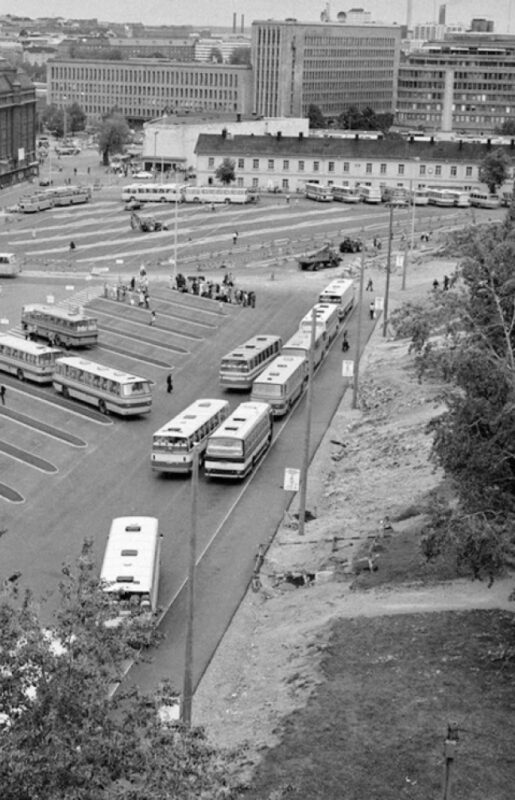
Plans for turning Kamppi into the modern business centre of Helsinki were made as early as the 1930s, but they were not realised until the 1970s. New commercial and office buildings were built in the area and old historical buildings were demolished. Photo: Erkki Salmela, 1977.
The many roles of Tennispalatsi
As Helsinki, the capital of independent Finland, continued to grow, public and private interest began to focus on the areas surrounding Kamppi and Töölönlahti. The region was seen as a suitable site for a new business centre that would embody modern commercialism, business, and urban living standards. The goal was to emphasise the modern European character of the young republic’s capital. This new era was briefly embodied by Oy Shell Ab gas station at the site of the former Turku barracks in 1928-1934.
Tennispalatsi, built in 1937, was another building meant to be temporary. It was originally built as a car maintenance building for the cancelled 1940 Olympics. The arched structures and four tennis courts, which gave the building its name, were built a year later. The building was leased for ten years to Auto-Palatsi Oy for the sale of cars and spare parts. At the 1952 Helsinki Olympics, basketball was played in the building, but it was soon returned to tennis players. Helsingin Verkkopalloseura was in charge of running the sports activities. Plans for the cultural use of Tennispalatsi began in 1993, and the building has been in its current use since 1999. Tennispalatsi houses a movie theatre and the Helsinki Art Museum HAM, which also took over the space of Kulttuurien museo (Museum of Cultures) as it moved out in 2015.
Kamppi – the centre of business and culture in the 21st century
Kamppi’s rise to Helsinki’s most important centre of commerce has been slow but consistent. Autotalo and its two sister towers, the buildings of the Pohja insurance company, were built in the 1950s to embody the era’s American-inspired ideals of city planning. Alvar Aalto’s long-awaited Kamppi-Töölönlahti plan from 1964 incorporated Kamppi definitively into the future business centre of Helsinki. In Aalto’s plan, the bus station, Lasipalatsi, and Tennispalatsi were replaced by a concentration of offices, commercial buildings, and retail stores. The new bus station was to be located in Leppäsuo. However, construction was slow and the monumental new business, office, and hotel buildings were only built along Salomonkatu in the 1970s.
Aalto’s vision was abandoned as times changed, but new plans continued to be made in the 1980s. Innotalo, lined with brass wall cassettes, was completed on the northern side of the Kampintori square in 1977. Hotel Presidentti was inaugurated in September 1980 by President Urho Kekkonen and Prime Minister Mauno Koivisto. The new buildings replaced the Maanviljelijäin Maitokeskus industrial and residential building. The Kamppi metro station opened in November 1983, and the new shopping centre Forum was opened on Simonkatu in 1985. It replaced the low and colourful store building of the same name from 1952.
The latest zoning plan for the centre of Kamppi was approved in 1999. The goal was to provide the area with “multifaceted activities that strengthen the competitiveness of the city centre, as well as downtown housing”. Construction started quickly. The first new project was hotel Scandic (2000). A decision was made to move the bus station underground. More apartments, retail stores, and business buildings were built in Kamppi. The urban atmosphere was emphasised with markets, squares, and event spaces.
The Kamppi square developed into Helsinki’s largest unified pedestrian zone and a new event area. Swedish artist Eva Löfdahl’s Yrittäjäveistos (“Entrepreneurs Monument”) was placed there in 2006. The wooden Kamppi Chapel (2012) and the Amos Rex art museum (2018) completed the area. By the 2020s, Kamppi has developed into an urban, commercial, and cultural living room that is open to everyone. The old bus station’s new role as a cultural centre is part of this development.
